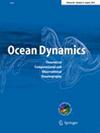界面重力-毛细管波的弱非线性调制
IF 1.9
3区 地球科学
Q2 OCEANOGRAPHY
引用次数: 0
摘要
摘要 针对上层流体速度均匀、带宽较宽的无穷深双层流体中的界面重力-毛细管波,推导了修正的非线性包络方程。该推导是在扎哈罗夫积分方程的基础上放宽了窄波带宽的限制,使其更适用于利用现实的海浪频谱。根据该方程,可在扰动波数空间绘制出不稳定区域。修改后的方程限制了均匀斯托克斯波的波带宽,与精确的数值结果非常吻合。我们还得出了纯毛细波情况下的调制不稳定性增长率。本文章由计算机程序翻译,如有差异,请以英文原文为准。
Weakly nonlinear modulation of interfacial gravity-capillary waves
Abstract
The modified nonlinear envelope equation of interfacial gravity-capillary waves in a two-layer fluid of infinite depths for broader bandwidth with a uniform velocity of the upper fluid is derived. The derivation is made from Zakharov’s integral equation by relaxing the narrow wave bandwidth restriction to make it more applicable for utilization of a realistic sea wave spectrum. From this equation instability regions are drawn in the perturbed wave number space. The modified equation limits the wave bandwidth of a uniform Stokes wave in an excellent agreement with the accurate numerical results. We have also drawn the growth rate of modulational instability for the case of pure capillary waves.
求助全文
通过发布文献求助,成功后即可免费获取论文全文。
去求助
来源期刊

Ocean Dynamics
地学-海洋学
CiteScore
5.40
自引率
0.00%
发文量
37
审稿时长
6-12 weeks
期刊介绍:
Ocean Dynamics is an international journal that aims to publish high-quality peer-reviewed articles in the following areas of research:
Theoretical oceanography (new theoretical concepts that further system understanding with a strong view to applicability for operational or monitoring purposes);
Computational oceanography (all aspects of ocean modeling and data analysis);
Observational oceanography (new techniques or systematic approaches in measuring oceanic variables, including all aspects of monitoring the state of the ocean);
Articles with an interdisciplinary character that encompass research in the fields of biological, chemical and physical oceanography are especially encouraged.
 求助内容:
求助内容: 应助结果提醒方式:
应助结果提醒方式:


